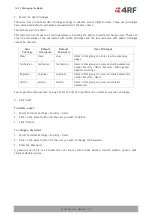
Managing the Radio | 129
Aprisa SRx User Manual 1.3.0
ETHERNET PRIORITY
This parameter controls the per port priority of the Ethernet customer traffic relative to the serial
customer traffic. If equal priority is required to serial traffic, this setting must be the same as the Serial
Data Priority setting.
The Ethernet Priority enables users to set the priority of Ethernet port ingress frames. The priority for
each port can be:
1. From PCP priority bits (VLAN priority) in VLAN tagged frames or priority tag (VLAN 0) frames
2. From DSCP priority bits in an IP packet (DSCP in IPv4 TOS field)
3. All frames are set to ‘very high’ priority
4. All frames are set to ‘high’ priority
5. All frames are set to ‘medium’ priority
6. All frames are set to ‘low’ priority
The default setting is Low.
A queuing system is used to prioritize customer traffic from the serial and Ethernet interfaces for over the
air transmission. A weighting may be given to each data type and this is used to schedule the next
transmission over the air e.g. if there are pending data packets in multiple buffers but serial data has a
higher weighting it will be transmitted first. The Ethernet buffer is 10 Ethernet packets (1 packet can be
up to Ethernet MTU, 1536 bytes).
There are four priority queues in the Aprisa SR: Very High, High, Medium and Low. Data is added to one of
these queues depending on the priority setting. Data leaves the queues from highest priority to lowest:
the Very High queue is emptied first, followed by High then Medium and finally Low.
Default Priority
When the priority of an Ethernet port uses the PCP bits (VLAN priority) values the ‘Default Priority’ option
is enabled, allowing the priority of untagged VLAN frames to be set.
When the priority of an Ethernet port uses the DSCP priority (in IPv4 TOS field) values the ‘Default
Priority’ option is enabled, allowing the priority of ARP frames to be set.
















































